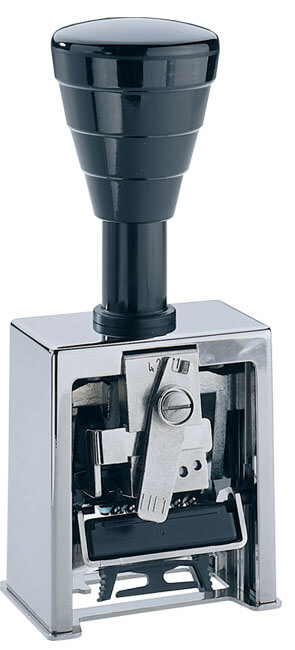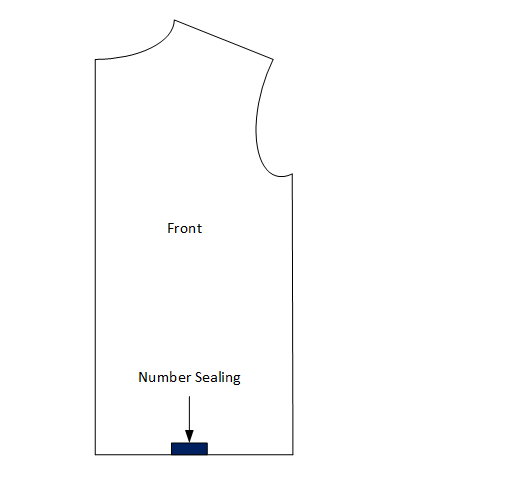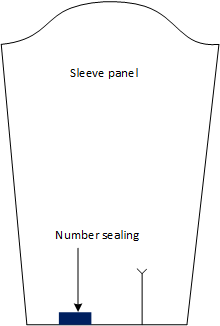Ink numbering garments is called Number Sealing. Number sealing or Ink numbering refers to printing number on the garment pieces by means of ink and stamping machine to identify the garment panels to be stitched together. It replaces the traditional method of pasting a numbered Sticker on garment pieces

img src – Horray
The Ink that is used can be either permanent or water Soluble.
Note: Ink characteristics depends greatly on the type of fabric it is applied on. Therefore every garment manufacturer knows that they cannot blindly trust an ink as permanent or water soluble. Therefore Precautions are always taken.
Why Number sealing garments is better than Numbering ?
- Permanent numbering: stickers may fall off the garment creating confusion in sewing line, leading to reduced efficiency and quality
- Time saving: time taken to remove and re-paste the sticker is saved.
Example : If the time taken to remove a numbering sticker off the garment and pasting it back again is 2 seconds and an operator is producing 60 pieces in an hour then in an hour we can save
120 second = 2 minutes which translates to 2 extra piece stitched per hour.
In a day of 8 hours this becomes 16 extra pieces produced per day
- No sticker stain marks on the garment.
Constraints for Number Sealing garments.
There are three constraints that determine whether number sealing on garments can be done or not:
- Visibility – The colour of fabric may camouflage the number sealed. There are different colours of ink available like white, silver, black, red, yellow and green hence before inking, the colour of ink should be appropriately chosen based on visibility. If any of the colour is not visible number sealing garments cannot be done.
- Transparency – If the ink is not completely hidden after the inked area has been covered by another layer of fabric.
- Absorbency – Some fabric will absorb more and hence when inked, the numbers will spread and smudge making them unreadable. Sealing cannot be done on highly hydrophobic and hydrophilic fabrics. Silicon coated fabrics pose a problem as they can be either hydrophobic or hydrophilic.
The big question, Where on garment panels should Ink Numbering be done?
Since we always want to take precaution in case the ink doesn’t wash off the garment completely sealing should always be done at the places:
- Which will fold inside and hide the inked number: Example – bottom hem of a shirt’s front panel

- Which will go inside another panel: Example: Edge of sleeve that will go inside cuff

- Which will be cut off the garment.
Example: At the extra length of the front placket.
Note – At some places there is absolutely no way we can avoid stickers. For parts which require stitch and turn like collar. Number sealing will be turned inside and would no longer be visible in that case it is required to give one sticker.
It is important to brainstorm and fix the position of number sealing to be done on every parts of a garment before moving to the implementation stage
Since it is a fairly new process there are lot of questions that are asked on how to get the implementation right some of them which I have encountered which I will try to answer are:
- How many number sealing machines should I buy to achieve the capacity required?
- How many garments can be inked by a bottle of ink? Is it cheaper as compared to garment numbering?
- How can a number be coded ? How to specify sizes with number?
- What type of number sealing machine should I buy ?
To answer all these question lets discuss implementation of number sealing in a garment manufacturing factory
How to implement number sealing on garments in a factory
- Number of sealing machines required: Number of sealing machines required is dictated by the fact that can one number sealing garments machine be used with different colors? My answer would be yes but that would require some serious cleaning to the machine. Since the pad used for applying ink by the machine can be replaced I am of the opinion that we can use a machine with different colors provided the machine is cleaned thoroughly. If the quality standards of the factory are high, discretion is advised. If you are ready to use a machine on multiple colors of ink Number of sealing machine = Number of operators + 2 (buffer)
- Ordering the Ink and Accessories: I could not find any studies or data on how many garment/panels one quart of ink can number seal. so I am going to give a very rough estimate and would urge everyone reading this to pour their valuable inputs or studies to deduce a precise figure .I would bet on around 50,000 shirts in one quart of ink. Accessories like pads ,finger tips, pointers are exhaustive in nature so we can stock them up.
- How to code the number? How to represent size with number?: Give a two digit number code to every size. example: 32 = XXS, 34=XS, 36 = S and so on .Once code for size is fixed the number coding for a 7 digit machine can be:

Number Coding For number sealing garments - What type of number sealing garments machine to buy? : There are different types of number sealing machines available in the market like 6 digit, 7 digit and 8 digit with additional option of having alphabetic dials as well. As mentioned in the code above it is clear that if a 6 digit machine is ordered blank space between the size and number will not be there and code will be difficult to read. Therefore 7 digit machine is a better option to have but again it can only number upto 9999 so if a factory receives big orders they should consider having an 8 digit machine. 8 digit machine also gives us the flexibility of sealing some additional information with number which might be required in some styles hence it scores well than other types. Now the final question
- Should I take all the pain to replace numbering sticker with Number Sealing on garments ? : A big Yes. It needs to be done if not today then tomorrow. It is faster , efficient, cleaner and leaner than numbering stickers.



kindly, suggest me a type of ink which is water soluble. we are facing a huge problem of staining because of ink numbering. is there any stamp Numbering ink that is water soluble.
Hi Muhammed, There are water soluble inks available but their solubility depend a lot upon on the fabric content . So you must test the ink before use. Below is the contact for a ink and numbering machine supplier, you may contact him directly him for water soluble ink.
email – sunsalesindia10@gmail.com
Name – Arvind Saxena
phone – +91-9871307660 , +91- 8766370810
Dear Muhammad plz share with me your whatsaap Number as i want to discuss about stamping in Garment industry with water soluble ink.
My Whatsaap number is 03000846395
hi,
we are interested for your Numbering Sealing machine to use and sale in Garments Industries in BD, requested to give us more details with machine , Ink price and video how it is working, etc for our study and further contact with you. our whatsapp. + 8801678000256 & e.mail : glorypm at yahoo.com
with best regards
A.K.Sikder
+8801678000256
Below is the contact for a ink and numbering machine supplier, you may contact him directly
email – sunsalesindia10@gmail.com
Name – Arvind Saxena
phone – +91-9871307660 , +91- 8766370810
Is there any stamp Numbering ink that is water soluble and also has MSDS (Material Safety Data Sheet)?
Yes .. there are claimed water soluble ink available but as the composition of fabric changes the ink might lose it solubility so it is advised to treat the ink as permanent all the time
Hello Varun Sanadhya.
Could you give me information and contact information to purchase the machine and ink?
Below is the contact for a ink and numbering machine supplier, you may contact him directly.
email – sunsalesindia10@gmail.com
Name – Arvind Saxena
phone – +91-9871307660 , +91- 8766370810